Prevention
The Centers for Disease Control and Prevention recommends using Standard Precautions (formerly called Universal Precautions) when caring for people. Standard Precautions is defined as treating all blood, body fluids, not intact skin, and mucous membranes as if they were infected with an infectious disease. A simple way to remember Standard Precautions is that all bodily fluids except sweat should be treated as if they were infected with an infectious agent. Under Standard Precautions, “body fluids” include saliva, sputum (fluid coughed up), urine, feces, semen, vaginal secretions, and pus or other wound drainage. The use of Standard Precautions is the only way to safely perform your job.
Hand Hygiene
The single most effective way to prevent the spread of infection is hand washing. Hands should be washed before and after patient contact. Wash hands during patient care as hands can become soiled. Wash hands with soap and water immediately after removing gloves. Wearing gloves does not eliminate the necessity for hand washing. If soap and water are not available, antiseptic hand cleanser or towelettes may be used, wash hands with soap and water as soon as possible. Hands should be scrubbed a minimum of 10 to 15 seconds.
Hand Hygiene Guidelines:
Improved adherence to hand hygiene (i.e. hand washing or use of alcohol-based hand rubs) has been shown to terminate outbreaks in health care facilities, to reduce transmission of antimicrobial resistant organisms (e.g. Methicillin Resistant Staphylococcus Aureus) and reduce overall infection rates.
CDC is releasing guidelines to improve adherence to hand hygiene in health care settings. In addition to traditional hand washing with soap and water, CDC is recommending the use of alcohol-based hand rubs by health care personnel. Alcohol- based hand rubs significantly reduce the number of microorganisms on skin, are fast- acting and cause less skin irritation for patient care because they address some of the obstacles that health care professionals face when taking care of patients. When using an alcohol-based hand rub, apply product to palm of one hand and rub hands together, covering all surfaces of hands and fingers, until hands are dry.
The use of gloves does not eliminate the need for hand hygiene. Likewise, the use of hygiene does not eliminate the need for gloves. Gloves reduce hand contamination by 70 to 80 percent, prevent cross-contamination and protect patients and health care personnel from infection. Hand rubs should be used before and after each patient just as gloves should be changed before and after each patient.
Personal Protective Equipment (PPE)
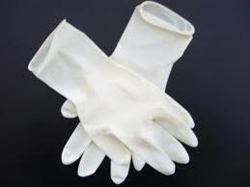 Gloves – Put on gloves before contact with non-intact skin or with blood or body substances. Change gloves between each patient procedure. Wear non-sterile, latex gloves when performing any clinical procedure that may expose the staff to the patient’s blood or other body substances. (e.g., with venipuncture and during perineal care) Sterile latex gloves are worn during certain clinical procedures that require sterile technique (e.g., during certain dressing changes or while inserting a urinary catheter). After each use, sterile and non-sterile latex gloves are discarded in a leak resistant waste receptacle, such as a plastic trash bag. Gloves – Put on gloves before contact with non-intact skin or with blood or body substances. Change gloves between each patient procedure. Wear non-sterile, latex gloves when performing any clinical procedure that may expose the staff to the patient’s blood or other body substances. (e.g., with venipuncture and during perineal care) Sterile latex gloves are worn during certain clinical procedures that require sterile technique (e.g., during certain dressing changes or while inserting a urinary catheter). After each use, sterile and non-sterile latex gloves are discarded in a leak resistant waste receptacle, such as a plastic trash bag. | |
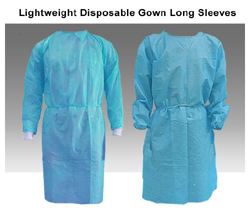 Gowns – Wear moisture-proof, disposable gowns if clothing may be contaminated with blood or other body substances. Remove personal protective equipment after use, and dispose of it according to department policy and procedure. Gowns – Wear moisture-proof, disposable gowns if clothing may be contaminated with blood or other body substances. Remove personal protective equipment after use, and dispose of it according to department policy and procedure. | |
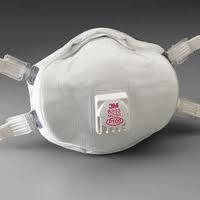 Masks – Disposable facemasks are worn whenever aerosolization or splattering of blood or other body substances may occur. Masks can also be used on a patient with an unknown respiratory disease to protect medical providers from the patient. Masks are not considered respiratory protection. Follow department procedure for disposal of mask. Masks – Disposable facemasks are worn whenever aerosolization or splattering of blood or other body substances may occur. Masks can also be used on a patient with an unknown respiratory disease to protect medical providers from the patient. Masks are not considered respiratory protection. Follow department procedure for disposal of mask. | |
| Respirators – For patients with an unknown respiratory illness, use a NIOSH-approved P-100 disposable respirator as a minimum respiratory protection or a respirator with a higher level of respiratory protection. Additionally, disposable respirators must have seal enhancing elastomeric components (e.g. rubber or plastic respirator to face seals) and must be equipped with two or more adjustable suspension straps. | |
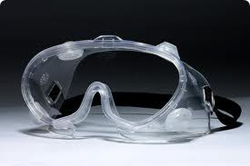 Goggles – Goggles or safety glasses with side shields are worn when aerosolization or splattering of blood or other body substances may occur to the eyes. Clean the goggles with soap and water after each use. If the goggles become cracked or heavily contaminated, discard them according to facility procedures. Goggles – Goggles or safety glasses with side shields are worn when aerosolization or splattering of blood or other body substances may occur to the eyes. Clean the goggles with soap and water after each use. If the goggles become cracked or heavily contaminated, discard them according to facility procedures. | |
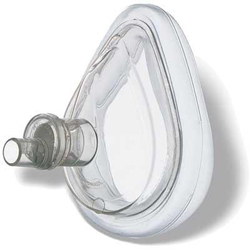 Disposable CPR Masks – Use disposable CPR masks if they are required to provide artificial mouth- to-mouth resuscitation or mouth-to-stoma ventilation. Disposable CPR Masks – Use disposable CPR masks if they are required to provide artificial mouth- to-mouth resuscitation or mouth-to-stoma ventilation. |
Handling Sharps
A needle-stick or a cut from a contaminated scalpel can lead to infection from hepatitis B virus (HBV) or human immunodeficiency virus (HIV), which causes acquired immune deficiency syndrome (AIDS). Few cases of AIDS have been documented from occupational exposure. The Occupational Safety and Health Administration (OSHA) standard covering blood-borne pathogens specifies measures to reduce these risks of infection.
Prompt Disposal: The best way to prevent cuts and sticks is to minimize contact with sharps. That prevention means disposing of them immediately after use. Puncture resistant containers must be available nearby to hold contaminated sharps – either for disposal or, for reusable sharps, later decontamination for reuse. Contaminated sharps must never be sheared or broken.
Recapping, bending, or removing needles is permissible only if there is no feasible alternative or if required for a specific medical procedure such as blood gas analysis. If recapping, bending or removal is necessary, the employees must use either a mechanical device or a hand-handed technique. If recapping is essential – for example, between multiple injections for the same patient – employees must avoid using both hands to recap. Employees might recap with a one-handed “scoop” technique, using the needle itself to pick up the cap and pushing cap and sharp together against a hard surface to reassure a tight fit. Alternatively, they might hold the cap with tongs or forceps to place it on the needle.
Sharps Containers: Containers for used sharps must be puncture-resistant. The sides and the bottom must be leak-proof. The container must be labeled or color-coded red to ensure that everyone knows the contents are hazardous. Containers for disposable sharps must have a lid, and they must be maintained upright to keep liquids and the sharps inside. Employees must never reach by hand into containers of contaminated sharps. Containers for reusable sharps could be equipped with wire basket liners for easy removal during reprocessing, or employees could use tongs or forceps to withdraw the contents. Reusable sharps disposal containers may not be opened, emptied, or cleaned manually. Containers need to be located as near to the area of use as feasible and safeguarded to ensure safety. The containers must be replaced routinely and not to be overfilled, which can increase the risk of needle sticks or cuts.
Additional Precautions
Along with the above recommendations regarding the use of Standard Precautions, hand washing, use of PPE and sharps handling, some more tips on preventing the spread of infection are provided below:
- Don’t insist that your physician give antibiotics if you do not need them. Antibiotics have no effect on illnesses caused by viruses.
- Take prescribed antibiotics exactly as instructed. Do not stop taking them without checking with your physician, even if the medicine makes you feel better or worse.
- Keep your immunizations up to date.
- Follow safe sexual practices.
- Do not use I.V. drugs. If you do, do not share needles.
- Don’t share personal items–such as razor blades, toothbrushes, comb, and hairbrushes–do not eat or drink from others’ plates or glasses.
- Keep kitchen surfaces clean, especially when preparing meat, chicken, and fish.
- Disinfect kitchen surfaces.
- Keep hot foods hot and cold foods cold; avoid leaving food out for an extended period.
- Remove gloves immediately when finished with procedure.
- Immediately wash all skin surfaces that have been contaminated with blood and body fluids. Flush skin with running water for one minute.
- Wear a disposal gown if you may come into contact with blood or body fluids (for example, emptying a urinary drainage bag). If your client has a contagious illness, you should wear a gown even if it is not likely you will come into contact with blood or body fluids.
- Wear a mask and protective glasses if the possibility exists that you will come into contact with splashing blood or body fluids (for example, emptying a bed pan)
- Wear gloves and use caution when handling razor blades, needles, and other sharp objects. Discard these objects carefully in a puncture-resistant, biohazard container.
- Avoid nicks and cuts when shaving clients.
- Carefully bag all contaminated supplies and disposes of them according to your agency’s policy
Recommendations for Emergency Responders
Get Vaccinated
- Get vaccinated against vaccine-preventable diseases.
- CDC Immunization Schedules for Healthcare Providers
- Public Health Agency of Canada (PHAC): Immunization Guide for Adults
Before the Run
- Ensure that you have your PPE readily available (respirators, masks, medical gloves, face/eye protection, gowns or garments)
During the Run
- Assume patients with respiratory symptoms are contagious
- Don your PPE before entering the patient area
- Strictly limit the number of crew members having direct patient contact
- Put a mask on the patient
- Create or promote good ventilation
After the Run
- Properly dispose of/clean exposed PPE
- Sanitize or wash your hands
- Properly clean/disinfect reusable medical equipment
- Decontaminate other equipment and vehicles
- Do not continue to wear contaminated clothing, and do not take any contaminated items, including uniforms, home
- Take care of your physical health (diet, rest)
- If you are exposed, report it
And Finally
- Do not go to work if you are sick